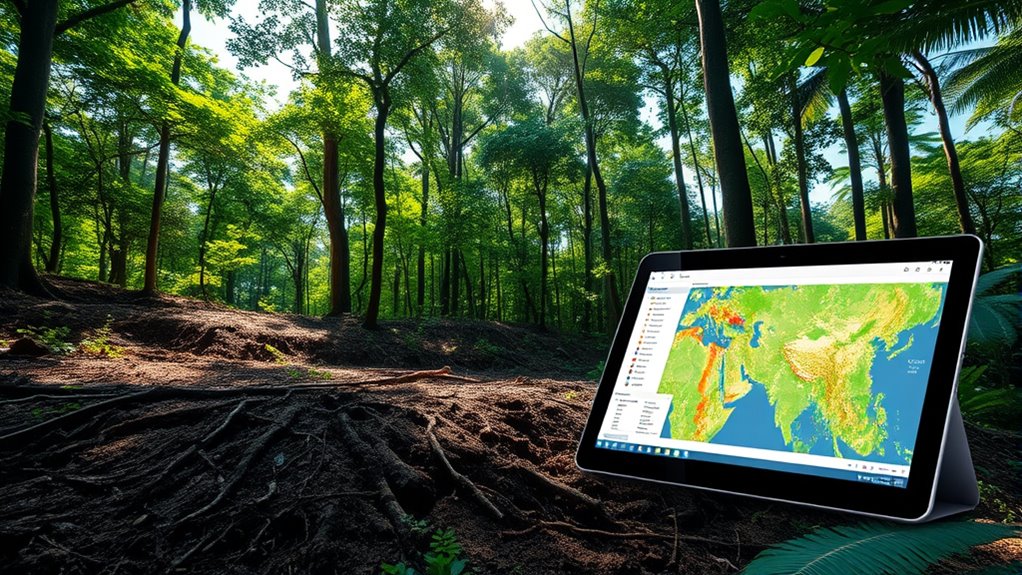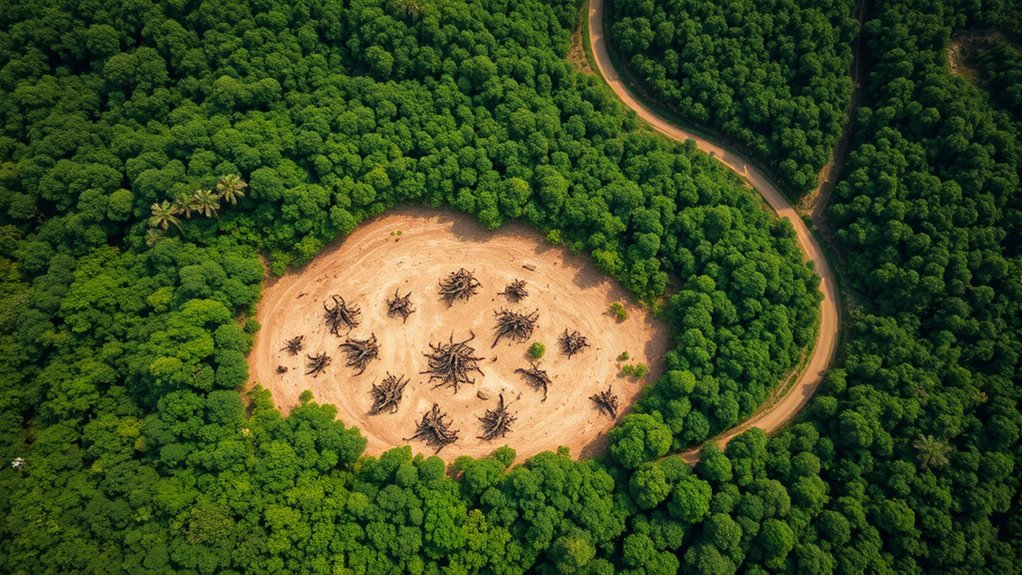To manage deforestation risk and improve traceability, you can use tools like blockchain for transparent data tracking, satellite monitoring to verify land use, and supply chain mapping software to identify sourcing origins. Key terms include certification standards such as FSC or RSPO, which set responsible sourcing benchmarks. These tools and terms help you guarantee sustainable practices and reduce environmental impact. Keep exploring further to discover how these solutions can support forest conservation efforts more effectively.
Key Takeaways
- Supply chain transparency tools like blockchain enable real-time tracking of raw materials’ origins.
- Satellite monitoring and remote sensing technologies detect deforestation activities in supply regions.
- Certification standards such as FSC and RSPO set criteria and validate sustainable sourcing practices.
- Key terms include “due diligence,” “supply chain mapping,” and “deforestation risk assessment.”
- Data management platforms integrate multiple data sources to improve traceability and identify deforestation hotspots.

As global demand for commodities grows, understanding and managing deforestation risk has become more essential than ever. When you’re navigating complex supply chains, transparency becomes your best tool. Supply chain transparency allows you to trace the origins of raw materials, pinpoint where deforestation might occur, and verify that every step aligns with sustainable practices. Without clear visibility into the journey of your commodities, you’re left guessing whether your sourcing contributes to forest loss or supports conservation efforts. Achieving transparency requires collaboration across multiple stakeholders, from producers to retailers, and often involves implementing technological solutions like blockchain or satellite monitoring to track products from forest to shelf. Names deserve careful, well‑sourced coverage to ensure the accuracy and credibility of information related to supply chain origins and practices. Certification standards play a crucial role in supporting responsible sourcing. These standards set benchmarks for environmental and social practices, helping you differentiate between sustainable and non-sustainable commodities. When you choose products that adhere to reputable certification standards—such as FSC (Forest Stewardship Council) or RSPO (Roundtable on Sustainable Palm Oil)—you’re making a conscious decision to support forest conservation. Certification involves rigorous assessments and audits, ensuring that the raw materials come from sources that follow strict guidelines on deforestation, habitat preservation, and community rights. By prioritizing certified products, you reduce the risk of unknowingly contributing to deforestation and demonstrate your commitment to sustainability.
Supply chain transparency helps trace raw materials, identify deforestation risks, and promote sustainable practices across stakeholders.
Implementing supply chain transparency and certification standards isn’t just about compliance; it’s a strategic move that mitigates risk and builds trust with consumers and partners. When you can confidently verify the origin of your commodities, you avoid potential reputational damage linked to deforestation scandals or illegal logging. Transparency also enables you to identify weak links or gaps in your supply chain, allowing for targeted interventions and improvements. Certification standards further reinforce your efforts by providing third-party validation, which enhances your credibility and demonstrates your dedication to responsible sourcing.
However, achieving full traceability isn’t always straightforward. Challenges include fragmented supply chains, inconsistent record-keeping, and limited access to reliable data, especially in remote or developing regions. To overcome these hurdles, you need to invest in advanced data management systems and foster strong relationships with suppliers who prioritize sustainability. Combining transparency initiatives with certification standards creates a comprehensive approach to managing deforestation risk, empowering you to make informed purchasing decisions that support forests and uphold your company’s values. In today’s market, proactive efforts toward traceability and certification are essential for aligning your business with global sustainability goals and protecting vital ecosystems for future generations.
Frequently Asked Questions
How Does Traceability Impact Local Communities?
Traceability impacts local communities by fostering community engagement and promoting cultural preservation. When you support transparent supply chains, you enable communities to participate actively in protecting their environment and traditions. This involvement guarantees they benefit economically and culturally, preserving their way of life. You help create a system where communities have a voice, encouraging sustainable practices that respect local customs and safeguard natural resources for future generations.
What Are the Costs of Implementing Traceability Systems?
You know what they say, “you have to spend money to make money.” Implementing traceability systems involves costs like technology adoption, training, and ongoing maintenance. Conducting a cost-benefit analysis helps you weigh these expenses against long-term gains, such as improved transparency and market access. While initial investments can be high, embracing traceability can boost credibility and sustainability, ultimately making it a smart choice for your business.
How Do Legal Frameworks Vary Across Countries?
You’ll find that legal frameworks vary across countries due to regulatory discrepancies, which can complicate implementation. Some nations pursue legal harmonization to align rules and standards, making traceability systems more consistent and effective. However, differing environmental laws and enforcement levels often create challenges, requiring companies to adapt to multiple legal requirements. Understanding these variations helps you navigate compliance, reduce risks, and guarantee responsible sourcing across different jurisdictions.
Can Traceability Prevent All Deforestation Activities?
Can traceability prevent all deforestation activities? While it considerably enhances supply chain transparency and helps verify compliance with certification standards, it can’t stop every illegal or harmful activity. Some actors may still evade detection or manipulate records. Traceability tools are essential, but they work best when combined with strict enforcement and global cooperation. Ultimately, it’s a powerful step, but not a foolproof solution to halt all deforestation.
What Are Future Technological Advancements in Traceability Tools?
Future technological advancements in traceability tools will likely include enhanced blockchain transparency and AI integration. You’ll see blockchain providing immutable, clear records of supply chains, making it easier to verify sustainability claims. AI will analyze vast data sets quickly, identifying risks of deforestation more accurately. These innovations will improve your ability to monitor, trace, and guarantee responsible practices, making deforestation harder to hide and increasing accountability across industries.
Conclusion
By understanding deforestation risk and traceability tools, you can make more informed decisions to protect forests. Did you know that over 80% of forest loss is linked to agricultural expansion? This highlights how crucial traceability is in monitoring supply chains and reducing deforestation. By leveraging these tools, you help guarantee sustainable practices, supporting both environmental health and responsible sourcing. Together, your efforts can make a meaningful impact on preserving our planet’s essential ecosystems.








